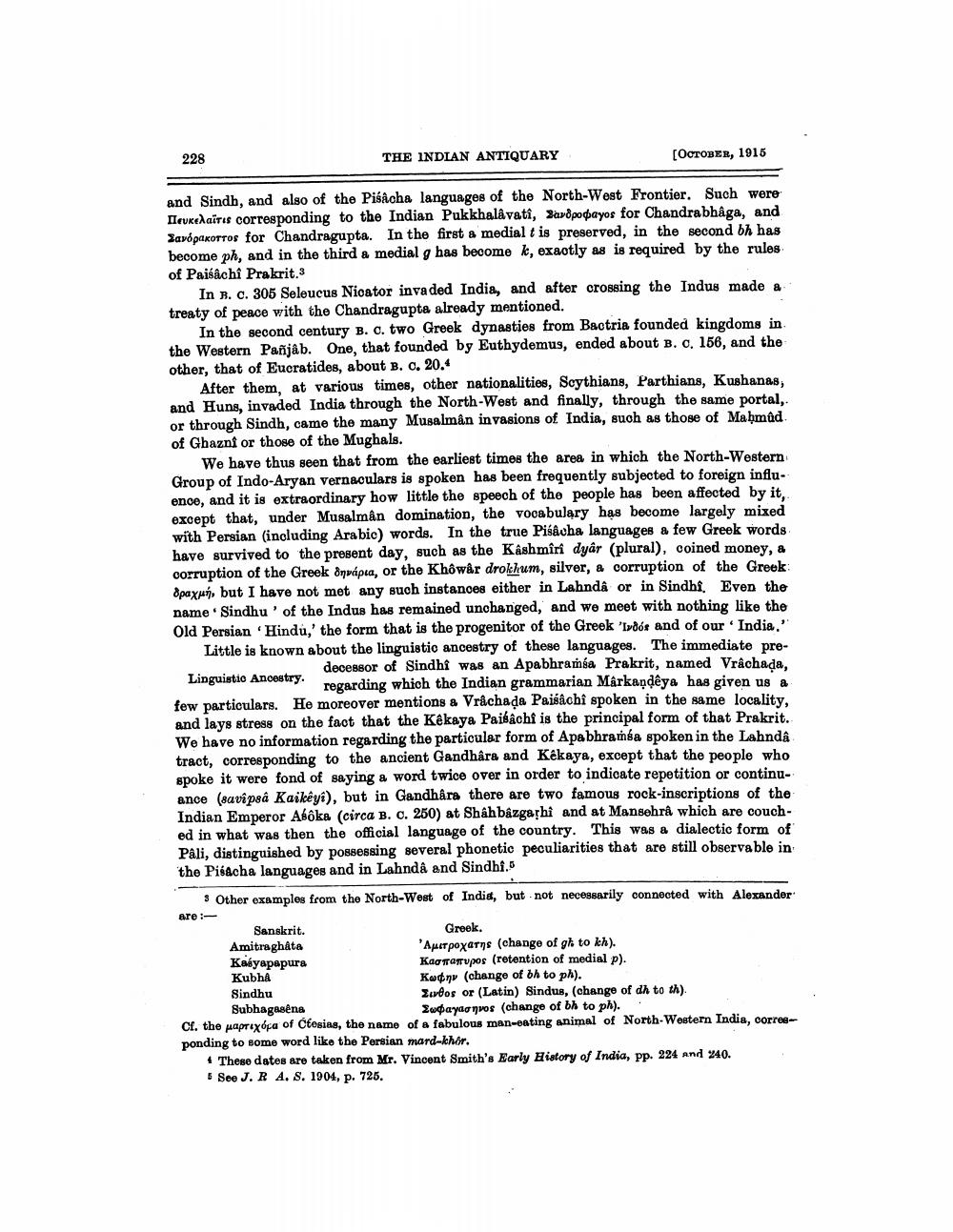________________
228
THE INDIAN ANTIQUARY
[OCTOBER, 1915
and Sindh, and also of the Pisacha languages of the North-West Frontier. Such were Πευκελαϊτις corresponding to the Indian Pukkhalavati, Σανδροφαγος for Chandrabhaga, and Savopakortos for Chandragupta. In the first & medial t is preserved, in the second bh has become ph, and in the third a medial g has become k, exaotly as is required by the rules of Paisachi Prakrit.3
In B. c. 305 Seleucus Nicator invaded India, and after crossing the Indus made a treaty of peace with the Chandragupta already mentioned.
In the second century B. o. two Greek dynasties from Bactria founded kingdoms in the Western Pañjâb. One, that founded by Euthydemus, ended about B. c. 156, and the other, that of Eucratides, about B. c. 20.
After them, at various times, other nationalities, Scythians, Parthians, Kushanas, and Huns, invaded India through the North-West and finally, through the same portal, or through Sindh, came the many Musalman invasions of India, such as those of Mahmûd of Ghazni or those of the Mughals.
We have thus seen that from the earliest times the area in which the North-Western Group of Indo-Aryan vernaculars is spoken has been frequently subjected to foreign influ. ence, and it is extraordinary how little the speech of the people has been affected by it, except that, under Musalman domination, the vocabulary has become largely mixed with Persian (including Arabic) words. In the true Piśâcha languages a few Greek words have survived to the present day, such as the Kashmiri dyår (plural), coined money, & corruption of the Greek önvápia, or the Khôwêr drokkum, silver, a corruption of the Greek 8paxuí, but I have not met any such instanoes either in Lahndâ or in Sindhi. Even the name. Sindhu' of the Indus has remained unchanged, and we meet with nothing like the Old Persian Hindu,' the form that is the progenitor of the Greek 'Ivdós and of our India.' Little is known about the linguistic ancestry of these languages. The immediate pre
decessor of Sindhi was an Apabhramsa Prakrit, named Vrâchada, Linguistic Ancestry.
sury: regarding which the Indian grammarian Markandêya has given us a few particulars. He moreover mentions & Vrachada Paisachỉ spoken in the same locality. and lays stress on the fact that the Kêkaya Paisachf is the principal form of that Prakrit. We have no information regarding the particular form of Apabhramba spoken in the Lahnda tract, corresponding to the ancient Gandhâra and Kekaya, except that the people who spoke it were fond of saying a word twice over in order to indicate repetition or continuance (savipsa Kaikeyi), but in Gandhåra there are two famous rock-inscriptions of the Indian Emperor Abóka (circa B. c. 250) at Shahbazgashi and at Mansehrâ which are couched in what was then the official language of the country. This was a dialectic form of Påli, distinguished by possessing several phonetic peculiarities that are still observable in the Pisacha languages and in Lahndâ and Sindhi.
• Other examplos from the North-West of India, but not necessarily connected with Alexander are : Sanskrit.
Greek. Amitraghấta
Aperpoxarns (change of gk to kh). Kalyapapura
Kagarupos (retention of medial p). Kubha
Κωφην (change of oh to ph). Sindhu
Zudos or (Latin) Sindus, (change of de to th). Subhagasens
Luqaydonros (change of bh to ph). Cf. the maprixóca of Ctesias, the name of a fabulous man-eating animal of North-Western India, corresponding to some word like the Persian mard-khor.
These dates are taken from Mr. Vincent Smith's Early History of India, pp. 224 and 240. See J. R A. S. 1904, p. 725.




